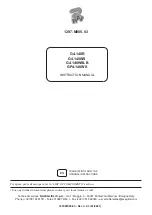
Assembly and Setup
Floor and Space Requirements
Floor must be solid and flat concrete. The balancer
does not need to be bolted to the floor in normal
service. The balancer may be bolted to the floor with
anchor bolts through the three support feet, but will
require an alternate electrical connection method.
Whether free standing or bolted to the floor, the
balancer must stand only on the three support feet
attached to the unit.
Sufficient space must be provided above and around
the balancer for mounting and demounting wheels.
Figure 1a - Space Requirements With Hood
Figure 1b - Space Requirements Without Hood
Unpacking the Unit
1. Remove the shipping carton from the pallet.
2. Remove all loose parts and accessories packed
around the unit.
Remove Balancer from Pallet
3. Remove the shipping bolts that hold the balancer
to the pallet.
Do not use the control pod, control pod arm,
faceplate, hood or stub
shaft to lift the balancer.
Use help to remove the
balancer from the pallet.
The unit is heavy and the
weight is not evenly distributed. Dropping the
unit may cause personal injury or equipment
damage.
4. Lift the balancer off the pallet and place it in its
operating location.
5. Install and tighten the threaded stud into the end
of the motor shaft.
Connecting to Power
Consult a licensed electrical contractor for proper
connection that meets local electrical codes. Power
outlets must be located in a floor raceway or
overhead drop if pedestrians or equipment traffic
pose a threat of damage to the power cord.
The balancer requires a nominal 115 VAC, 60 Hz,
single-phase power supply with a 15 amp fuse or
circuit breaker and a three-pin safety outlet.
Electrical outlets must have a solid connection of less
than 1 ohm between the ground pin and building
ground.
Operation with a defective
ground circuit will create a
shock hazard for the
operator, damage the unit electronics, and will
void the warranty.
Power and ground requirements must be verified by
the installer or an inspector before connecting the
balancer. Failure to observe this precaution may void
the warranty.
If the balancer is bolted to the floor, a licensed
electrical contractor must be consulted. Most
electrical codes require “hard” wiring when the
balancer is bolted down.
Figure 2 - Electrical Outlet Requirements
Initial Testing
1. Plug the unit into an appropriate power outlet. If
the circuit breaker for the outlet is off, turn it on.
2. Turn the balancer on. The power switch is on the
back of the unit.
COATS 700 Balancer • 1
WARNING
CAUTION
CAUTION
Single-Phase
115 VAC
115 V
between A &
B
A - White
B - Black
Ground - Green
48 inches
56 inches
76 inches
41 inches
41 inches
70 inches
Summary of Contents for COATS 700
Page 2: ...ii COATS 700 Balancer ...
Page 14: ...8 COATS 700 Balancer Notes ...
Page 15: ...COATS 700 Balancer 9 Notes ...





















